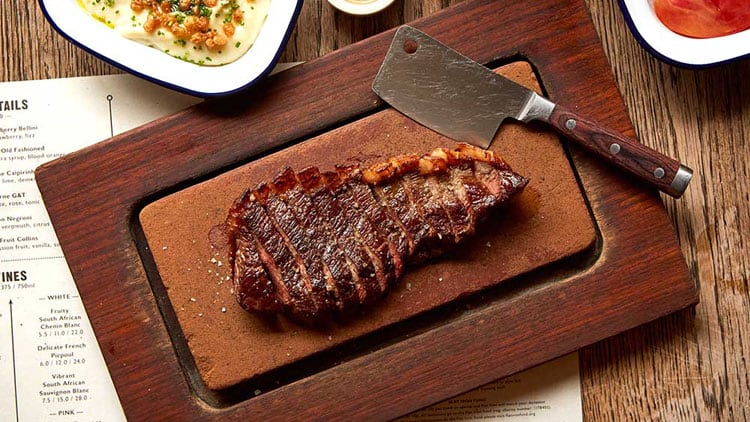Charlie Carroll’s vision when he was developing the idea that would eventually launch in 2012 as Flat Iron was simple: make great steak available to everyone. London’s restaurant scene at the time was dominated, primarily, by high-end steakhouses that chiefly catered for wealthy office workers and special family occasions, and Carroll wanted to create something that had much broader accessibility while not skimping on the quality of the meat served.
Building the concept, though, took time. Carroll, who was previously an operations advisor at Wahaca, spent nine months teaching himself butchery, learning about the lesser-known secondary cuts of beef, and working through a 38-strong list of suppliers, trying to find the right beef for his mission. Eventually, he alighted on the flat iron – a lesser-known cut from the featherblade, taken from just below the shoulder of the animal.
From there, he formed a blueprint for a concept featuring a tight menu built around the eponymous steak. Fast forward to today and Flat Iron operates an 18-strong estate across the UK, primarily based in London but with a growing regional footprint that includes sites in Cambridge, Manchester and, soon, Brighton.
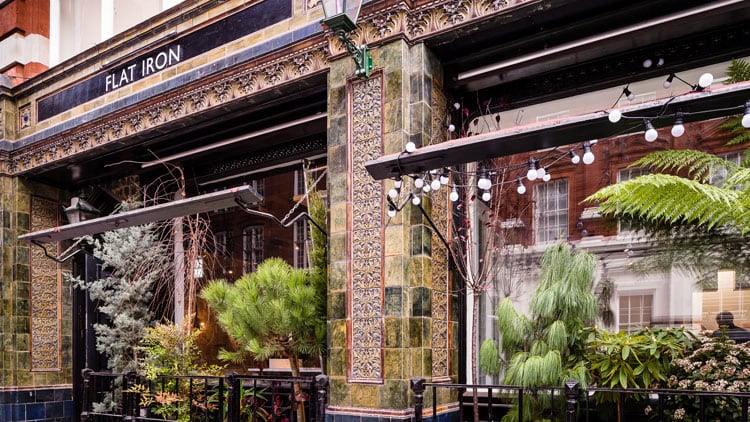
Earlier this month, the group received a further boost to its expansion ambitions with the news that private equity backers McWin Capital Partners and TriSpan had partnered to secure a co-control majority investment in Flat Iron. It’s the latest chapter in Flat Iron’s story, which, through Carroll’s vision, has seen it go from London pub residency to national chain.
2012
Carroll launches Flat Iron as a pop up above The Owl and Pussycat pub in London’s Shoreditch in July 2012. The concept, with its emphasis on a single, accessibly priced steak cut available to order with a short range of sides, immediately catches the attention of London’s diners and within two weeks diners are queuing for up to 90 minutes to snag a table, with Carroll butchering the steaks himself each day ahead of service. The early buzz gives Flat Iron the credibility it needs with landlords to move into bricks and mortar and a month later the business secures a nil-premium, kitchen-fitted site in Soho’s Beak Street for its first permanent restaurant, which opens in the autumn.
2013
Flat Iron’s Soho restaurant proves itself quickly, turning tables sometimes more than six times a day. In less than a year, Carroll secures the support of NatWest. “Frankly, I was slightly amazed that they came on board,” he would later tell Restaurant. “I wasn’t expecting to have any debt funding for the first two or even three sites, but we were able to do 50:50 cash flow/debt for our second site, and NatWest has supported me ever since.”
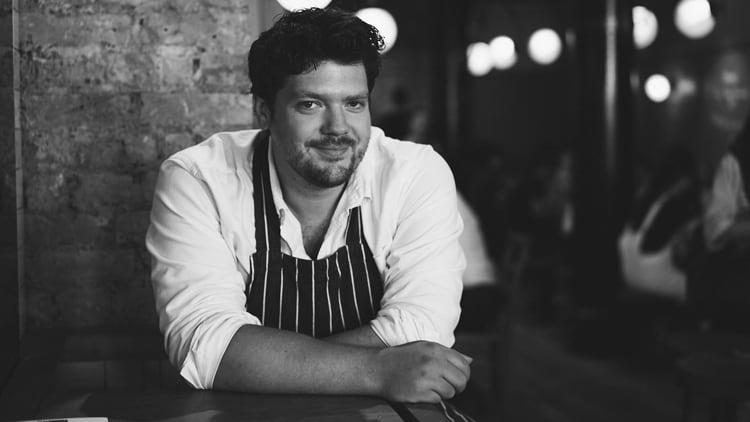
2014
Getting funding for Flat Iron’s sophomore site might have been straightforward, but finding it is far from easy. Carroll looks at around 50 sites before coming across the one on Denmark Street that eventually launches as the group’s second restaurant. The opening is marked by a ceremonial spit roasting of a whole ox at The Ship pub in Wandsworth, a spectacle that showcases the group’s dedication to beef, and which also marks the first partnership with the then pub landlord Oisin Rogers, with whom Carroll would open The Devonshire in 2023.
2015
Flat Iron’s third restaurant sees the group expand outside of Soho for the first time, taking over a prominent site on Henrietta Street in Covent Garden. At 90 covers, it is Flat Iron’s biggest site to date and, unlike its two Soho locations, boasts its own working butcher’s shop.
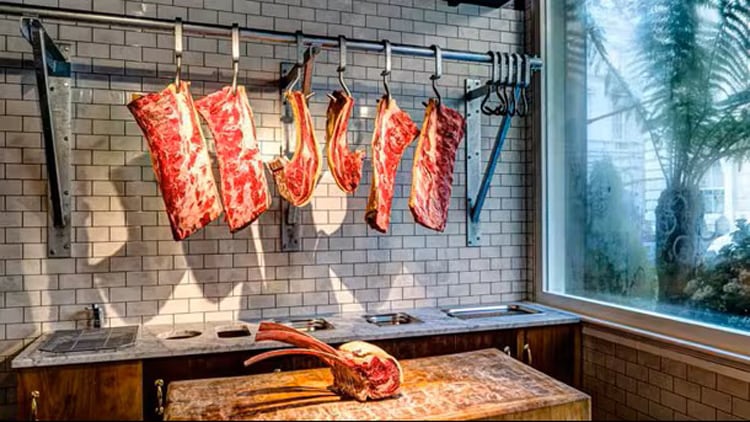
2016
The group marks its fifth birthday with the opening of its fourth London restaurant, this time on Curtain Road in Shoreditch. The celebrations continue later in the year when the group wins two gongs at Restaurant’s R200 Awards for Most Effective Restaurant Design and Best Value Restaurant Operator with fewer than 20 sites.
2017
By 2017, Flat Iron is selling 10,000 of its signature steaks every week, and its success has caught the eye of Piper, a consumer specialist investor. Piper subsequently invests £10m into Flat Iron in 2017, providing the company with the necessary funding to help Carroll build out his senior team and open further sites in and around London. Following the investment, former Wahaca MD Jo Fleet joins the group as managing director, and Fred Smith comes on board as head of beef. A fifth restaurant, on Goldborne Road in Notting Hill, also opens.
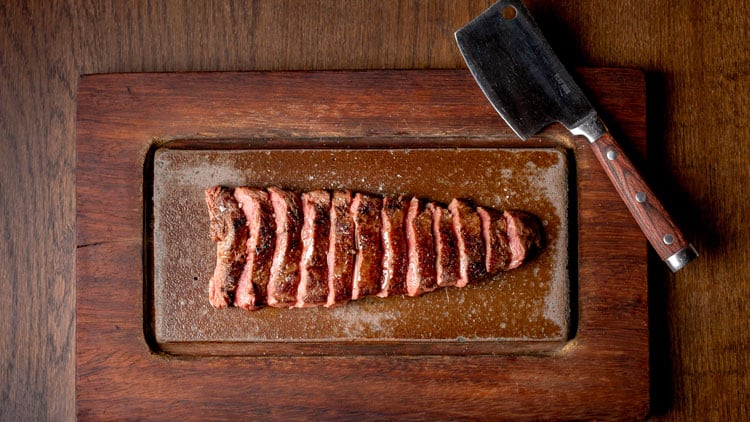
2018
With the backing of Piper, Flat Iron begins ramping up its plans for expansion. Speaking at the Casual Dining Show, Fleet says the company is looking to grow its five-strong footprint in the capital despite ‘uncertain’ conditions in the market. A sixth restaurant, in King’s Cross, opens later in the year.
2019
2019 proves to be a significant year for Flat Iron. In January, the group receives a £5m funding package towards its expansion from alternative lender ThinCats. Openings in London Bridge and Spitalfields follow, as does the group’s first closure – its Notting Hill restaurant forced to shut after just two years trading as a result of a rent hike. 2019 also sees Flat Iron explore the possibilities of diversifying its portfolio for the first time. For the launch of Arcade Food Theatre it creates the Flat Iron Workshop, giving its chefs the space to play around with different dishes, including steak cooked over a bespoke holm oak-fired grill and served in a giant, beef dripped-Yorkshire pudding with pickled Tropea onions, English mustard mayonnaise and fresh horseradish. Later in the year the group also launches a feasting concept in collaboration with The Winemakers Club. Unlike Flat Iron’s other restaurants, Flat Iron X The Winemakers Club, which takes over the former Barullo site near Liverpool Street Station, features long feasting tables and a stripped-back food menu that majors in Scottish bavette steak served alongside beef-dripping chips and jugs of béarnaise sauce. This is paired with an extensive selection of more than 50 wines, all available as magnum bottles.
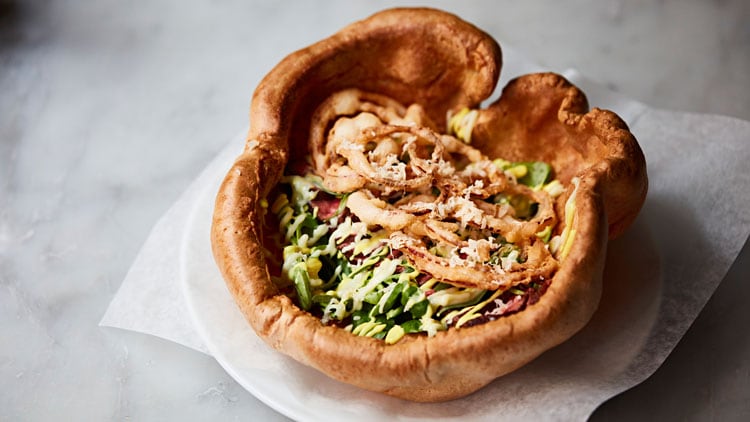
2020
Flat Iron X The Winemakers Club relaunches under the group’s core concept in January, the feasting concept relabelled as a ‘pop-up’. Two months later, the Covid-19 pandemic forces all restaurants across the UK to close, leaving businesses facing an unpredictable and, in numerous cases, perilous future. Flat Iron, like many operators in the space, pivots to selling delivery boxes through an online shop. The Flat Iron butcher’s box features a selection of prime steaks and secondary cuts, as well as burgers and a traditionally prepared hind-quarter roasting joint, overseen by Smith and the group’s in-house butcher Calum Eades. Despite the impact of the pandemic, the group also pushes ahead with further growth and returns to the expansion trail later in the year with a restaurant opening in Marylebone. The group’s Liverpool Street restaurant, meanwhile, eventually closes permanently.
2021
Despite the continued impact of the pandemic on operations, Flat Iron continues to expand with the launch of its ninth restaurant on Clink Street in the heart of Bankside. There is also significant changes to the group’s senior team with Jo Fleet leaving to pursue other opportunities within the sector and Byron founder Tom Byng – a long-time friend of Carroll’s – coming in as CEO.
2022
The group’s tenth birthday celebrations include the launch of its tenth London restaurant, in Waterloo. Further openings in the capital are also planned out, but, perhaps most significantly, Carroll begins actively exploring opportunities to take the brand outside of London for the first time.
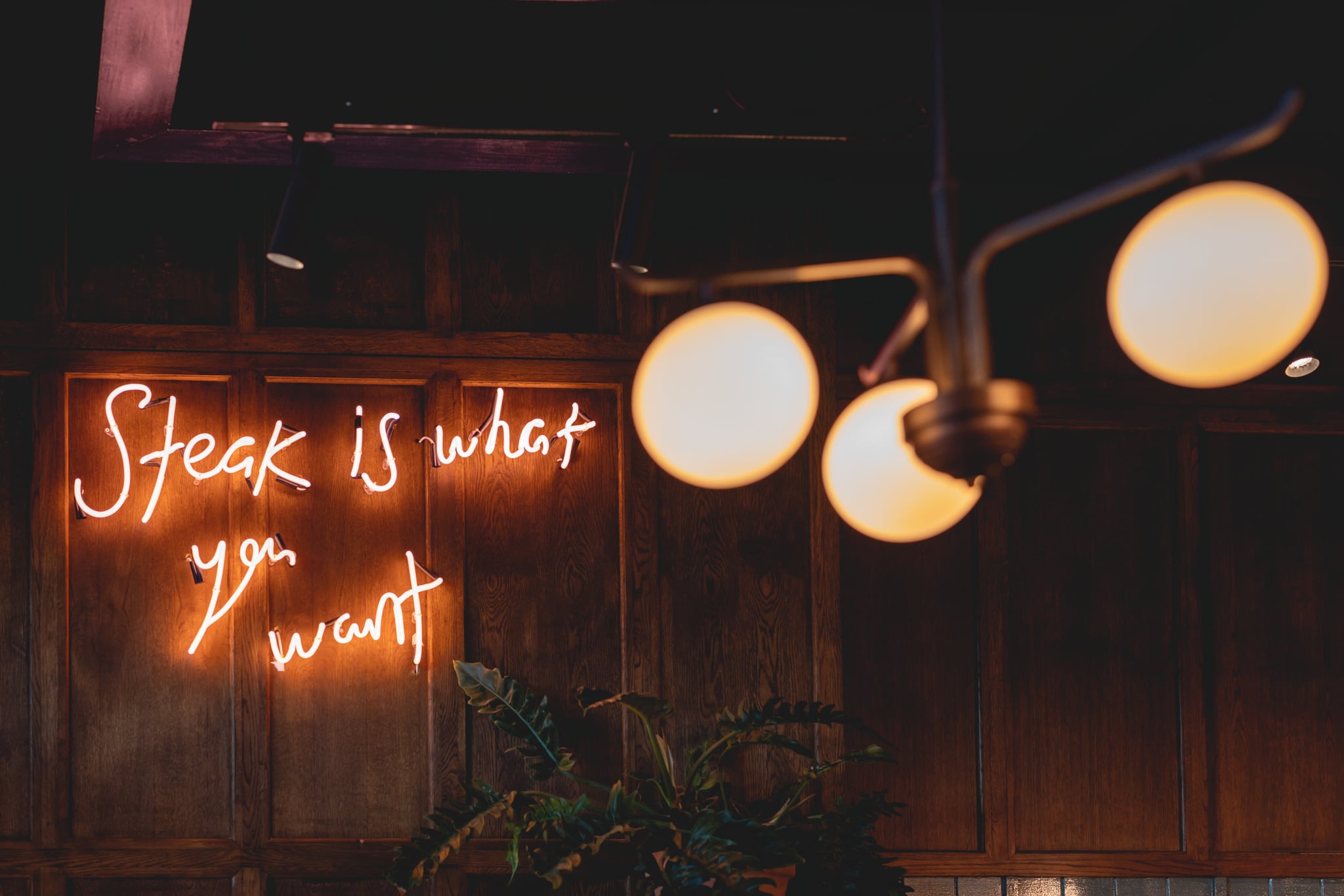
2023
Flat Iron make its first moves outside of London in July, opening a huge 120-cover restaurant on Market Street in Cambridge. It follows this in the autumn with a second regional site, this time in Leeds. Additionally, the group continues to grow its London estate with a new opening in Kensington. Like many operators, Flat Iron also finds itself locked in a battle for a business interruption insurance payout in the wake of the Covid-19 pandemic.
2024
A strong start to the year sees Flat Iron announce the launch two further London restaurants alongside its first in Manchester. It follows record sales for the group, with turnover rising 52.9% from £23.5m to £35.9m. Flat Iron’s ongoing success leads it to appoint advisers to review its strategic options later in the year including, potentially, third-party investment or a possible sale of the business.
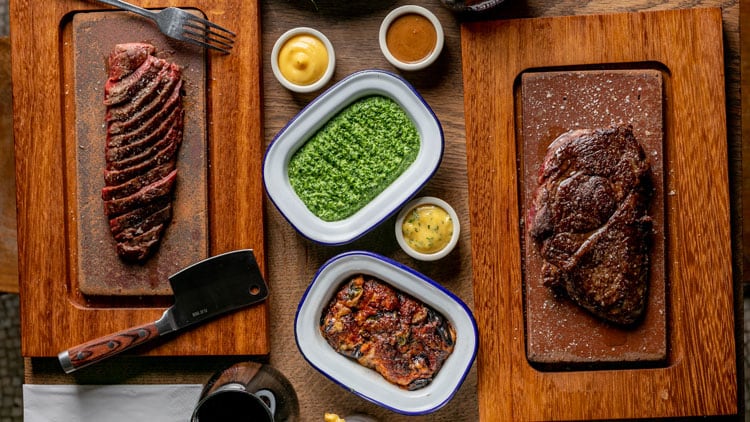
2025
Flat Iron reports another set of record results with sales rising to £49.6m and underlying profit reaching £5.7m. Plans for further expansion inevitably follow, with the group announcing the opening of its fifteenth London restaurant and its eighteenth site overall within the Royal Festival Hall on the Southbank. Further regional openings are also confirmed, with sites in Brighton and Bristol set to launch before the end of the year. In August following months of rumours, it is revealed that McWin Capital Partners and TriSpan have partnered to secure a co-control majority investment in Flat Iron. The deal, which sees Piper exit the business, aims to support Flat Iron’s growth, including further UK expansion and international market entries. Tom Byng continues to lead the steakhouse group under its new ownership.
With new financial backing, it feels like the right time for Flat Iron to hit the accelerator
From Flat Iron’s early days, Charlie Carroll has been vocal about the brand’s potential. Speaking to Restaurant back in 2016, when the group had just four sites, he reasoned that Flat Iron could work anywhere in the UK. “People who have opinions I respect have said it could be a 100 to 200- site chain, and I think it could be,” he said at the time. “There are very few places it couldn’t go. But do I want that? Probably not imminently. Am I conscious of expanding too quickly? Definitely.”
Indeed, it’s notable how measured Flat Iron’s expansion has been in the years since its launch; building little and often rather than opting for mass scale. Yet, with McWin and TriSpan now backing the business financially, it feels like the time is right for the group to hit the accelerator.
The genius of Flat Iron’s strategy lies in its USP. Steakhouses have long been pitched at a premium market, and this is reflected in the price point. They are a place for long, leisurely, and often celebratory meals. Flat Iron’s approach thrives in its contemporariness: the dwell time is often short - around an hour - the menu is tight, and the prices are affordable. When it launched above The Owl and Pussycat in 2012, a Flat Iron steak cost £10 without sides. Today, even with recent and well-documented rises in beef prices, it costs £15; with chips, it comes in at £19.
It's a strategy that not only appeals to the crash-strapped millennials, but also the younger Gen Z diners who are prone to prioritising convenience and quick service when eating out, often choosing fast-casual establishments and fast-food outlets for their efficient ordering and service. Flat Iron neatly pitches itself to those markets, while maintaining a more premium experience than operators in either of those spaces can offer. No wonder its revenue is reaching record highs year-on-year.
In terms of future growth, Flat Iron has already said it is aiming to open four to five new restaurants a year, which would see its estate at least double by the end of the decade. There’s also talk of the group exploring opportunities overseas. It’s a business with plenty of irons in a fire that’s growing stronger and stronger.


